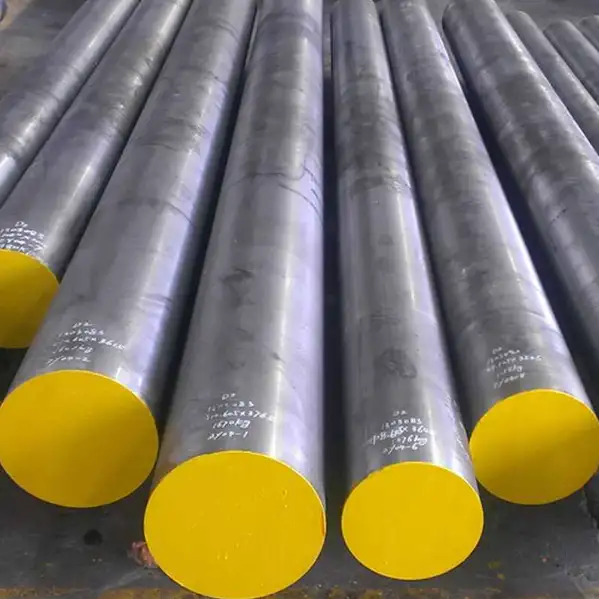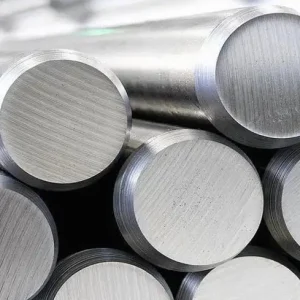4140 alloy steel round bar is a workhorse grade: medium-carbon chromium-molybdenum steel that combines high strength, fatigue resistance and good toughness after heat treatment; for most shafts, axles, couplings and high-stress fasteners it offers the best overall cost/benefit ratio versus many alternatives. Practical supply today (stock bar, quenched & tempered rod, or ground stock) means purchasers can get reliable mechanical performance at factory prices from credible Chinese producers such as MWAlloys without sacrificing traceability or delivery speed.
What is 4140 round bar?
4140 is a medium-carbon, chromium-molybdenum low-alloy steel normally supplied as round bar in forms including hot-rolled, cold-drawn (annealed), forged, and quenched & tempered. It is intended for parts that need a good balance of strength, toughness and wear resistance and that may require post-heat-treatment to reach specified tensile or hardness levels. Typical UNS designation is G41400 (SAE/AISI 4140).
Chemical composition
The table below lists commonly accepted composition ranges for SAE/AISI 4140. Individual mills may supply slight variations; always verify with the mill test report (MTR).
| Element | Typical range (wt%) |
|---|---|
| Carbon (C) | 0.38 – 0.43 |
| Manganese (Mn) | 0.75 – 1.00 |
| Phosphorus (P) | ≤ 0.035 |
| Sulfur (S) | ≤ 0.040 |
| Silicon (Si) | 0.15 – 0.30 |
| Chromium (Cr) | 0.80 – 1.10 |
| Molybdenum (Mo) | 0.15 – 0.25 |
| Nickel (Ni) | trace / typically ≤ 0.30 |
(Reference datasheets and SAE/AISI summaries show these standard ranges.)
Mechanical & physical properties
Below are representative property ranges — final values depend heavily on heat treatment (annealed vs quenched & tempered).
| Property | Typical value (annealed) | Typical value (quenched & tempered / hardened) |
|---|---|---|
| Density | ~7.85 g/cm³ (0.284 lb/in³) | same |
| Ultimate tensile strength (UTS) | ~655 MPa (95 ksi) | up to 1000–1100+ MPa depending on temper |
| Yield strength (0.2% offset) | ~415 MPa (60 ksi) | varies 600–1000 MPa |
| Elongation (in 50 mm) | ~20–25% | drops to ~10–16% when hardened |
| Hardness (Brinell) | ~180–220 HB (annealed) | up to HB 300+ (or HRC 55+) depending on Q&T. |
| Modulus of elasticity | ~190–210 GPa | same |
For designers, tables that map hardness (HRC / HB) to expected tensile/yield are commonly used; consult mill certificates for traceable values.
Common specifications, designations and equivalents
-
SAE/AISI: 4140 (UNS G41400).
-
EN: 42CrMo4 (often specified in Europe; close equivalent, designation 1.7225).
-
JIS / Japanese: SCM440 is the common analogue.
-
ASTM references: bars often conform to ASTM A29 / A108 for general bar stock or A322/A304 variants depending on supply form. Check the spec called out on the PO.
Sizes, weight per unit length and supply forms
Supply forms: hot-rolled bar (cores, billets), cold-drawn ground bar (precision), forged blanks, quenched & tempered rods.
Representative weight chart (selected diameters — imperial units common in North America):
| Diameter (in) | Weight per foot (lb/ft) | Common stock form |
|---|---|---|
| 1/4" | 0.100 – 0.167 | cold drawn |
| 3/8" | 0.376 | round bar |
| 1/2" | 0.66 | round bar |
| 3/4" | 1.50 | stock / cut-to-length |
| 7/8" | 2.05 | Q&T or annealed |
| 1" | 2.67 | wide availability |
| 1.5" | 6.01 | heavy bar |
| 2" | 10.68 | heavy bar |
(Weight data from North American stockholders and mills; metric equivalents use standard density calculation.)
Heat treatment, hardening and machining practice
-
Annealing / normalizing: used to improve machinability and relieve stresses. Annealed condition yields best ductility for machining.
-
Quench & temper (Q&T): common for final parts; quench (oil) from ~820–870°C then temper to achieve target hardness/strength. Mechanical properties vary strongly with temper temperature.
-
Welding: possible but preheat and post-weld heat treatment recommended for heavy sections to avoid brittle zones.
-
Machining hints: run higher feeds on annealed material; for hardened stock, use carbide tools and reduced DOC. 4140 has moderate machinability (~60–70% relative to mild steel in annealed).
Principal applications
-
Automotive: axles, shafts, drive components.
-
Oil & gas: drill collars, tool joints (industrial versions).
-
Machine building: couplings, bolts, gears, mandrels.
-
Heavy equipment: pins, studs, high-stress fasteners.
-
Tooling: die holders, arbor shafts (when surface treatment/nitriding applied).
4140 vs 4340 steel
-
Main chemical difference: 4340 includes nickel and generally has higher carbon and nickel content; this yields greater toughness and fracture resistance at comparable strengths. 4340 is often chosen for critical aerospace and high-fracture-toughness components. 4140 is more economical and still highly capable for many shaft/axle roles where extreme fracture toughness is not mandatory.
Recommendation: choose 4140 for cost-sensitive high-stress rotating parts; select 4340 when your application requires higher fracture toughness, especially at low temperature or for heavy cross-sections that must maintain toughness.
Price comparison (2025) — USA • Europe • China
Important caveats: steel pricing is volatile. Final buyer prices depend on process state (annealed vs Q&T), quantity, certification (MTR/ISO), shipping, and local duties/taxes. The ranges below are indicative (bulk pricing for commercial lots, mid-2025 market context).
| Region | Typical price range (bulk, per tonne equivalent) | Typical retail / small order indicator |
|---|---|---|
| China (factory FOB) | ≈ RMB 8,000 – 12,000 / tonne (~$1,100–$1,650/tonne) for base 4140 bar stock; price per kg commercial quotes on platforms vary. Alibaba vendor listings align with mid-range factory pricing. | single-ton lots on Alibaba show per-kg quotes in that band. |
| USA (domestic distributors, finished Q&T stock) | ≈ $2,000 – $3,500 / tonne (wide spread; small-order retail much higher per kg) — retail vendors (MetalsDepot, OnlineMetals, McMaster) list cut-to-length pricing with per-piece premiums. | online retailers show per-foot pricing for small orders; expect significant markup vs mill price. |
| Europe (ex-works mills / stockholders) | ≈ €600 – €900 / tonne for generic steel commodity indicators (hot rolled coil reference); alloy stock and certified bars typically carry premiums — practical delivered prices for alloy bars often align with €700–€1,300 / tonne depending on spec. | European price indexes show recent downward pressure but alloy bars remain pricier than commodity coil. |
How to interpret: China factory FOB prices are often the lowest for large volumes; total landed cost (duties, inland freight, certification testing) can narrow the gap. U.S. and EU distributor prices include logistics, cutting, certification and inventory margins. For large projects, request MTR-backed quotes and compare delivered cost (DDP/CIF) rather than FOB.
Procurement checklist & quality control
-
Mill Test Report (MTR): ensure chemistry and mechanicals traceable to ASTM/SAE.
-
Specified condition: annealed, normalized, Q&T and target hardness must be on PO.
-
Certs: ISO9001, steel mill certificates, non-destructive test reports if required.
-
Sample testing: hardness checks (HRC/HB), tensile testing on blanks for first shipment.
-
Surface/size tolerances: peeled vs turned vs ground; pick the supply form that minimizes machining.
-
Logistics: confirm lead times, stock status, and whether factory price includes inspection.
FAQs
-
Is 4140 oil-quenched required?
Not always — annealed or normalized stock is common for machining; oil quench and temper used to reach higher hardness/strength. -
Can 4140 be nitrided?
Yes. Nitriding gives excellent surface wear resistance while keeping core toughness. Ensure compatible heat treatment sequence. -
What is typical hardness after Q&T?
Typical quenched and tempered ranges are HRC ~20–55 depending on temper temperature; specify required HRC on the order. -
Is 4140 magnetic?
Yes, it is a ferrous alloy and will respond to magnets. -
Are 4140 and 42CrMo4 identical?
They are near-equivalents; 42CrMo4 is the common European designation with similar composition and properties. Always confirm required spec language. -
Will welding degrade mechanical properties?
Welding heavy sections may affect hardness and toughness; preheat and PWHT recommended for critical parts. -
How does 4140 perform in fatigue?
Good fatigue resistance after proper heat treatment; surface treatments (shot peen, nitriding) further improve fatigue life. -
What surface finishes are available?
Black (hot-rolled), peeled, turned, ground, centerless ground. Ground finish reduces machining cost but costs more up front. -
Typical lead time from Chinese mill?
Stock items can ship in days; heat-treated or customized orders typically require weeks. (MWAlloys offers expedited stock shipping on many SKUs.) -
How to select between 4140 and 4340?
Use 4340 if higher fracture toughness or low-temperature performance is critical; choose 4140 for cost/availability balance.
why choose MWalloys for 4140 round bar
MWAlloys is a China-based manufacturer focused on alloy bars and precision stock. Key selling points we offer to international buyers:
-
Factory pricing: direct factory quotations — typically 100% factory price for standard stock and OEM volumes.
-
Fast inventory dispatch: multiple SKUs kept in near-term stock; typical stock orders can ship from factory within 3–10 business days depending on diameter and finish.
-
Quality certificates: full MTRs against SAE/ASTM specs, optional third-party inspection and hardness/tensile reports.
-
Value add: pre-machining, Q&T, and nitriding available under one PO.
-
Export experience: documentation, packaging for sea/air shipment, and global logistics partners.





